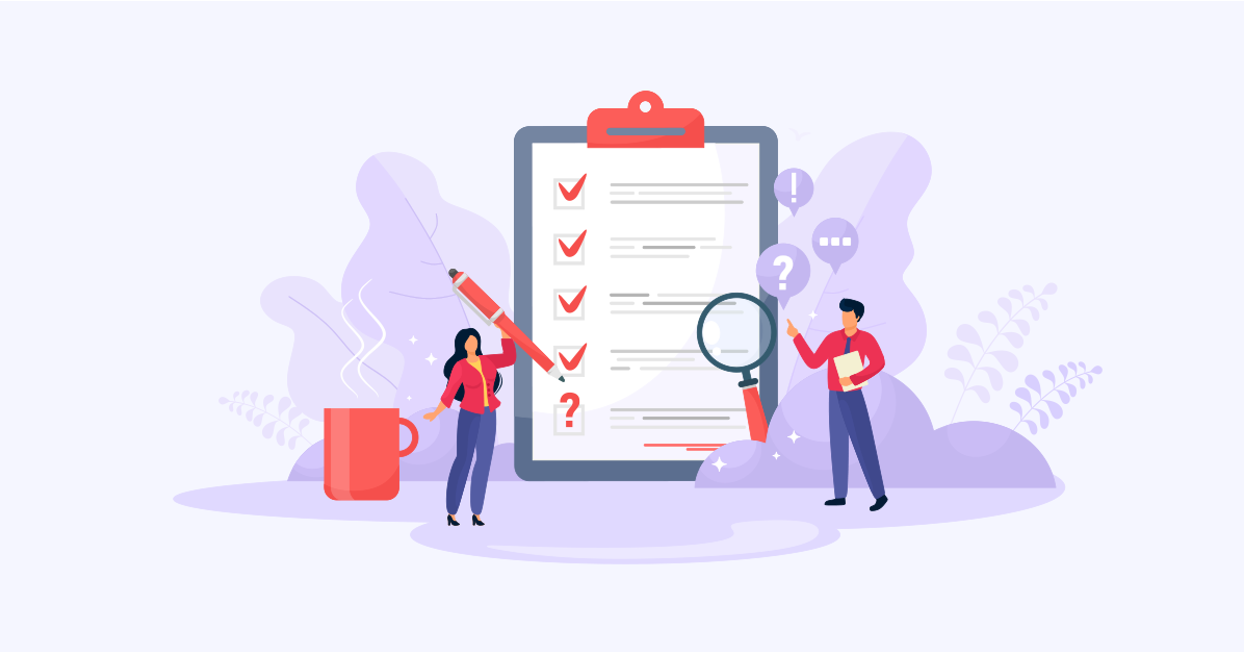Posted on May 24, 2024
As a savvy organizer of events such as conferences, webinars, or virtual summits, you know that the event is not over when the lights go out and the last guests leave. You know that the true value of an event lies in the insights gathered from the attendees. It may be hard to hear, but you want honest, raw feedback from those who experienced the event firsthand.
You probably wonder what really went through the attendees’ minds. Were they hanging onto every word from the speakers? Did the networking opportunities live up to their expectations? And, most importantly, did the event leave a mark on them?
But how will you get that feedback? You could stand around with questionnaires on a clipboard and ask people as they leave, but that is so last millennium. The trick is to send tailor-made surveys to everyone involved – be they organizers, attendees, or speakers – soon afterward to mine their wealth of ideas on every aspect of the event.
The post-event survey is not just another item on your checklist. It is a window into understanding the true impact of your event.
In this article, we explore the power of post-event survey questions, whether you want to measure satisfaction with the content and speakers or the logistics and the overall attendee experience. Making improvements based on the survey results can mean the difference between an average event everyone forgets about by next Tuesday and one that leaves a long-lasting impression.
So, let’s look at some post-event survey sample questions you could ask to maximize the value of your feedback surveys.

Post-Event Survey Questions Examples
You poured your heart (and budget) into your event, but did it land? The best way to find out is with an event satisfaction survey.
A good survey includes a mix of different types of questions. For instance, you can ask straightforward Yes/No or rating questions (as these are great for measuring overall satisfaction and identifying pain points) or open-ended questions that let respondents freely share their thoughts, ideas, and feedback without restrictions. These types of questions are more challenging to analyze but are a great way to get valuable qualitative insights.
Most post-event surveys will include the same standard questions, such as:
- Suggestions for improvements:
- Which aspects could be improved for future events?
- Did the event meet your expectations?
- What was your favorite moment of the event?
- Demographic information:
- What is your age group?
- What is your occupation or industry?
- What is your primary reason for attending this event?
- Overall event satisfaction:
- How would you rate your overall satisfaction with the event?
- Did the event meet your expectations? Yes or No.
- Why or why not?
- Logistics and organization:
- On a scale from 1 to 10, how would you rate the event’s organization, including registration, venue, and facilities?
- Were there any logistical issues or challenges you encountered during the event?
Keep in mind that a well-designed survey strikes a balance between different types of questions. Mix and match to capture both quantitative data (ratings, rankings) and qualitative insights (feedback, suggestions).
Public Events: After Event Survey Questions
Public events come in all shapes and sizes and can include book fairs, concerts, and festivals as well as sports events and trade shows. Whether you organized a fundraiser, charity event, or marathon, you can use survey questions afterwards to unlock the secrets of what made your event a hit—or how it can be even better next time.
Some questions specific to public events could be as follows:
- Would you recommend this event to a friend or colleague? (Yes/No)
- How convenient was the location of the event?
- You can also ask about parking and accommodation issues, if relevant.
- How did you hear about the event? Was the event promotion clear and informative?
- On a scale of 1-5, how satisfied were you with the variety of food and beverage options?
Conferences: Event Feedback Survey Questions
Professionals, academics, or enthusiasts in a particular field or industry meet at conferences and conventions to share knowledge, network, and discuss trends and developments.
Generally, conferences are smaller, more focused events centered around a specific theme, topic, or industry. They often feature keynote speakers, panel discussions, workshops, and presentations to educate and engage attendees.
On the other hand, conventions are larger events that bring together a broader audience and may encompass multiple related topics or industries. They often include exhibitions, trade shows, and networking opportunities, in addition to information sessions. It is possible that a convention can attract thousands of attendees and may span several days. Just think of Comic-Con International or the World Economic Forum.
Include some of the following event evaluation questions:
- On a scale of 1 to 5, how well did the conference agenda align with your professional interests?
- Were the speakers able to effectively answer audience questions?
- Did you make any new connections that will benefit your professional development?
- Were you satisfied with the conference venue and facilities?
- Which breakout sessions did you find most informative and why?
Training Courses: Survey Questions After an Event
Training events can encompass a wide variety of types. This list is by no means exhaustive:
- Workshops: These are hands-on sessions where attendees can develop specific skills (often soft skills) in a particular area, for instance, leadership, communications or project management.
- Onboarding and orientation training: At these events, new employees typically undergo orientation to familiarize themselves with company policies, procedures, and organizational culture. Onboarding goes beyond orientation and could cover topics such as team dynamics, company values, and job-specific training.
- Product knowledge training: At this type of training, employees learn about products or services that they will sell or support.
- Diversity, Equity & Inclusion (DE&I) Training: DE&I training is focused on creating awareness, understanding, and inclusivity within the workplace. It addresses biases, cultural competence, and respectful communication
- Compliance Training: This type of training ensures that employees are aware of and understand all relevant laws, regulations, and company policies. Compliance training can cover a wide range of topics, such as anti-discrimination laws, workplace-safety procedures, and data-security protocols.
Now, let’s look at some survey questions that can be used after a training event:
- Were the hands-on exercises in the training course helpful in solidifying your understanding?
- On a scale of 1-10, how engaging and effective were the training methods and delivery by the instructor?
- What additional resources (e.g., cheat sheets, tutorials) would be helpful for further learning?
- How would you rate the pace and flow of the training sessions? Was it too fast, too slow, or just right?
- Were there any topics or areas that you feel were not adequately addressed in the course?
Post Virtual Event Survey Questions for Attendees
Virtual events have become increasingly popular in recent years due to their convenience and accessibility. Even in a post-Covid world, these types of events are as popular as they were once necessary during the pandemic. Whether you are organizing a virtual trade show, careers fair or product launch, you have to measure the success of the event, perhaps even more so than for a real-life event where it is possible to read the room and make changes on the fly.
Here are some examples of questions that you can use after a virtual event:
- On a scale of 1 to 10, how would you rate your overall experience at the virtual event?
- How would you rate the usability and functionality of the virtual event platform?
- Did you experience any technical difficulties during the event? Yes/No
- Optional: If yes, please specify.
- Did the virtual event platform provide adequate opportunities for interaction with other attendees? Use a scale of 1 to 5.
- How many virtual events have you attended in the past year?
Webinars: Survey Questions After Webinars
Webinars are virtual events conducted over the Internet. They can be live or pre-recorded. Participants join remotely from anywhere using a computer, tablet, or smartphone.
At a webinars you will typically have a presentation, often with slides or visuals, and – for live events – it may also include interactive elements such as polls, Q&A sessions, and chat features. Companies often use webinars as marketing events to educate potential and existing customers about a company’s products or services and to generate leads for sales teams.
Include some of these questions in your post-event survey:
- How likely are you to recommend this webinar to others (on a scale of 1-10)? (NPS question)
- Did the webinar start and end on time?
- Did the webinar provide new insights or information that you found valuable?
- Were you able to participate and ask questions during the webinar?
- Would you attend another webinar by the same presenter or organization?
Identifying the Optimal Time to Distribute Post-Event Surveys
Now that you have a better idea of what to add to a post-event survey let’s look at when you should send it. Remember, the goal is to strike a balance between sending the survey while the event is still fresh in people’s minds but not when participants have become too busy after the event to respond thoughtfully.
While there is no single “perfect” time to send the event feedback surveys, there are guidelines that you can keep in mind.


- Event type and duration:
-
-
- For events shorter than two hours, aim to send the survey within 24 to 48 hours as memories – and enthusiasm – can fade quickly, and you can measure feedback while their memories are still fresh.
- For multi-day events, consider sending a short event feedback form mid-event to gauge initial impressions and identify areas that can be improved immediately. Then, follow up with a more comprehensive survey one to two days after the event’s conclusion.
-
- Audience:
-
-
- Avoid sending surveys on Mondays and weekends, as these are times when people are more likely to be overwhelmed with work or personal commitments.
- If your event has a global audience, try to segment your survey distribution based on time zones. Aim for a time that’s convenient for the majority of attendees in each region.
-
- Survey length and complexity:
-
-
- A short survey (one that takes between five and ten minutes) should be sent out sooner rather than later after the event.
- A survey that will take more than 15 minutes to complete should be sent a few days after the event when attendees have had time to reflect.
-
- Question types:
-
-
- Include a mix of closed-ended (rating scales, multiple-choice) and open-ended questions.
- Open-ended questions allow attendees to share detailed feedback and insights beyond predefined options. These could be more difficult to analyze but could present you with wonderfully honest responses.
-
- Industry trends:
-
-
- Research suggests that Tuesdays, Wednesdays, and Thursdays tend to have higher survey response rates than weekends or Mondays.
- Studies also show that sending surveys in the morning (around 10 am) can be more effective than sending them later in the day
-
- Delivery methods:
-
- Choose the channel that will work best for your audience. This can include email, text messages, an event app, social media, or a website. Email is a common and effective method, as most people have email addresses.
- Customize your survey by audience type. You will get different responses from attendees than from sponsors or speakers. You don’t want to bore or irritate someone with irrelevant questions.
Here are some additional tips to keep in mind:
- Prepare the post-event survey before the event takes place. This allows you to send it out without delay once the event concludes. However, you may need to adjust some questions as the event unfolds. Something that you thought might be an issue can prove to work perfectly (or vice versa!)
- Tell attendees that you are going to send a survey. This can prepare them and encourage participation.
- Offer a small incentive to encourage them to complete the survey. Perhaps give a discount for a next event, an Amazon voucher or a raffle entry. This can increase the response rate and show attendees that their feedback is valued.
- Coordinate the distribution of surveys with other post-event activities, such as sending thank-you emails or sharing event highlights. This will maintain attendee engagement.
- Limit your follow-up emails to two emails to avoid overwhelming attendees. Don’t be pushy or aggressive.
- Perhaps the most important tip is to spend enough time crafting clear, well-structured questions that avoid ambiguity and bias.
- Ask the right questions.
- Ensure that the questions are clear, relevant, and – above all – actionable. Your aim is to gather specific feedback that will help you understand attendees’ experiences and identify areas for improvement.
- Avoid asking vague or leading questions. You don’t want someone to abandon the survey because they don’t understand the questions. .
- Additionally, keep the survey concise and easy to complete to maximize response rates.

Conclusion
In a nutshell, you no longer have to guess how to create effective post-event surveys. Just tailor your questions to your specific event format and pinpoint the optimal distribution window. This way, you can unlock a treasure trove of attendee insights.
Remember, the most valuable surveys go beyond surface-level satisfaction and encourage actionable feedback. So, use the examples and strategies discussed in this article to design surveys that transform your events from good to great, time and time again.



